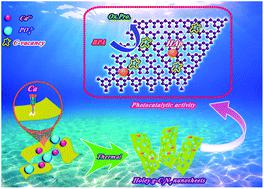Our official English website, www.x-mol.net, welcomes your
feedback! (Note: you will need to create a separate account there.)
In situ synthesis of holey g-C3N4 nanosheets decorated by hydroxyapatite nanospheres as efficient visible light photocatalyst
RSC Advances ( IF 3.9 ) Pub Date : 2021-09-22 , DOI: 10.1039/d1ra05259d Mohammad Chahkandi 1 , Mahboobeh Zargazi 2 , Afsaneh Ahmadi 1 , Ehsan Koushki 3 , Arman Ghasedi 3
RSC Advances ( IF 3.9 ) Pub Date : 2021-09-22 , DOI: 10.1039/d1ra05259d Mohammad Chahkandi 1 , Mahboobeh Zargazi 2 , Afsaneh Ahmadi 1 , Ehsan Koushki 3 , Arman Ghasedi 3
Affiliation

|
The interesting g-C3N4 nanosheet morphology has drawn huge attention in photocatalytic applications because of its special features. Nonetheless, the relative activity of these nanosheets is still controversial due to the low available active sites and the high recombination probability of photo-induced charge carriers. In this work, in situ sol–gel approach was applied to synthesize holey g-C3N4 nanosheets/hydroxyapatite (HAp) nanospheres with plentiful in-plane holes. Herein, the presence of Ca2+ plays a key role in the formation of holey defects on 2D g-C3N4. In-plane holes provide nanosheets with more active edges and diffusion channelsv, resulting in a tremendous enhanced mass and photo-induced charge transfer speed. Moreover, the holes make highly numbered boundaries, which lead to the prevention of aggregation. On the other hand, distributed nano-HAp spheres on these nanosheets can form effective heterojunctions having high photo-degradation ability of pollutants. Intrinsic O-vacancies inside HAp unit cells mainly affect the capture of photogenerated electrons, pollutant molecules, and O2 gas. The synergistic presence of O-vacancies and holey defects (C-vacancies) on 2D g-C3N4 plays a key role in raising the photocatalytic performance of holey g-C3N4/HAp. It can be concluded that the proposed preparation method is a promising approach for simultaneous synthesis of holey g-C3N4 and surface heterojunctions of Ca-based materials. This new structure has shown significant degradation ability of bisphenol A, a prominent pollutant, with a low amount (0.01 g) and short time.
中文翻译:

原位合成羟基磷灰石纳米球修饰的多孔 g-C3N4 纳米片作为高效可见光光催化剂
有趣的gC 3 N 4纳米片形貌因其特殊的特性而在光催化应用中引起了极大的关注。尽管如此,由于可用活性位点低和光生载流子复合概率高,这些纳米片的相对活性仍然存在争议。在这项工作中,采用原位溶胶-凝胶方法合成了具有大量面内孔的多孔gC 3 N 4纳米片/羟基磷灰石(HAp)纳米球。在此,Ca 2+的存在在2D gC 3 N 4上多孔缺陷的形成中起着关键作用。面内孔为纳米片提供了更活跃的边缘和扩散通道,从而极大地提高了质量和光致电荷转移速度。此外,这些孔形成了高度编号的边界,从而防止了聚集。另一方面,分布在这些纳米片上的纳米HAp球可以形成有效的异质结,具有高污染物光降解能力。HAp晶胞内的固有O空位主要影响光生电子、污染物分子和O 2气体的捕获。2D gC 3 N 4上O-空位和多孔缺陷(C-空位)的协同存在对于提高多孔gC 3 N 4 /HAp的光催化性能起着关键作用。可以得出结论,所提出的制备方法是同时合成多孔gC 3 N 4和Ca基材料表面异质结的有前途的方法。这种新结构对主要污染物双酚A表现出显着的降解能力,且用量低(0.01克)且时间短。
更新日期:2021-09-22
中文翻译:

原位合成羟基磷灰石纳米球修饰的多孔 g-C3N4 纳米片作为高效可见光光催化剂
有趣的gC 3 N 4纳米片形貌因其特殊的特性而在光催化应用中引起了极大的关注。尽管如此,由于可用活性位点低和光生载流子复合概率高,这些纳米片的相对活性仍然存在争议。在这项工作中,采用原位溶胶-凝胶方法合成了具有大量面内孔的多孔gC 3 N 4纳米片/羟基磷灰石(HAp)纳米球。在此,Ca 2+的存在在2D gC 3 N 4上多孔缺陷的形成中起着关键作用。面内孔为纳米片提供了更活跃的边缘和扩散通道,从而极大地提高了质量和光致电荷转移速度。此外,这些孔形成了高度编号的边界,从而防止了聚集。另一方面,分布在这些纳米片上的纳米HAp球可以形成有效的异质结,具有高污染物光降解能力。HAp晶胞内的固有O空位主要影响光生电子、污染物分子和O 2气体的捕获。2D gC 3 N 4上O-空位和多孔缺陷(C-空位)的协同存在对于提高多孔gC 3 N 4 /HAp的光催化性能起着关键作用。可以得出结论,所提出的制备方法是同时合成多孔gC 3 N 4和Ca基材料表面异质结的有前途的方法。这种新结构对主要污染物双酚A表现出显着的降解能力,且用量低(0.01克)且时间短。











































 京公网安备 11010802027423号
京公网安备 11010802027423号